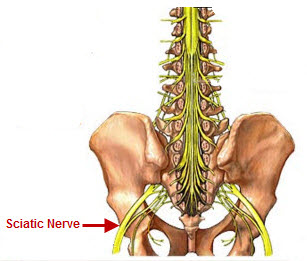Sciatica refers to pain, weakness, numbness, or tingling in the leg. Sciatica is usually caused by a herniated or |
| bulging inter vertebral lumbar disc. It is an injury to or compression of the sciatic nerve. Sciatica occurs when there is damage to the sciatic nerve, located in the back of |
 |  | ||||
 |
|
 | |||
 |  |
Sciatica pain can vary widely. It may feel like a mild tingling, dull ache, or a burning sensation. In some cases, the pain is severe enough to make a person unable to move. The pain most often occurs on one side. Some people have sharp pain in one part of the leg or hip and numbness in other parts. The sensations may also be felt on the back of the calf or on the sole of the foot. The affected leg may feel weak. The pain often starts slowly. Sciatica pain may get worse:
Sciatica might be revealed by a neuromuscular examination of the legs. There may be weakness of knee bending or foot movement, or difficulty bending the foot inward or down. Reflexes may be abnormal, with weak or absent ankle-jerk reflex. Pain down the leg can be reproduced by lifting the leg straight up off the examining table.Most cases of sciatica are treatable with physical therapy. After 4-6 weeks of treatment, an individual should be able to resume normal activities. Spinal manipulative therapies are those that are used on the human skeleton, particularly the spinal area, to relieve muscular or skeletal pain, relieve tension, improve the mobility of joints and, in the case of the oriental therapies, to "unblock energy channels." The idea behind spinal manipulation is that when the vertebrae are misaligned, the resulting pressure on nerves can have negative effects on organ system function and general health, in addition to impeding proper joint motion. Treatment: Spinal manipulative therapies will generally work. The therapies vary from light touching to fairly vigorous manipulation. |
The information provided on this site is not a substitute for professional medical advice, examination, diagnosis, or treatment. Always seek the advice of a qualified health care provider with any questions you may have regarding a medical condition. If you think you may have a medical emergency, call your doctor or 911 immediately. |























